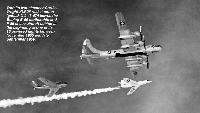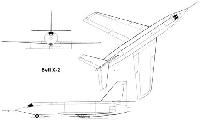
Bell Model 52 (Х-2)
Bell Model 52, заказанный как Х-2, имел отдаленное сходство с экспериментальными прототипами серии Х-1 и отличался от них стреловидными крылом и оперением. Самолет проектировался для проведения исследований полетов на высоких скоростях (до М=3) и на больших высотах. Крыло и другие места, по расчетам подвергавшиеся действию высоких температур из-за кинетического нагрева, выполнялись из нержавеющей стали. В фюзеляж установили множество приборов, в том числе и для сбора информации о воздействии нагрева на конструкционные материалы. Х-2 оснащался ракетным двигателем Curtiss Wright XLR25-CW-1 с регулируемой тягой. Шасси имело носовое колесо и однополозковую основную стойку под фюзеляжем, которая дополнялась стабилизирующими костылями под крылом. Для установки Х-2 на позицию под самолетом-носителем использовалась наземная управляемая тележка, специально адаптированная под Boeing B-50, который предварительно поднимали на гидравлических домкратах, чтобы возможно было осуществить подвеску.
Испытательная программа началась 27 июня 1952 года с полетов без запуска ракетного двигателя.
Сначала проводилась проверка на испытываемые нагрузки и готовность ракетных топливных систем. Но в результате взрыва прототип оторвало от B-50. Самолет упал с высоты 9145 м в озеро Онтарио, погиб главный летчик-испытатель фирмы "BELL".
Второй Х-2 полетел 18 ноября 1955 года, а 7 сентября 1956 года он достиг высоты более 38405 м. 27 сентября 1956 года Х-2 развил скорость М=3,196, которую превысили лишь в 1961 году. Но этот полет закончился катастрофой. Самолет начал входить в неуправляемый левый крен, установка руля направления вправо и другие действия результатов не дали. На скорости М=3 самолет вошел в плоский штопор и разбился.
ТАКТИКО-ТЕХНИЧЕСКИЕ ХАРАКТЕРИСТИКИ
Bell X-2
Тип: одноместный опытный самолет
Силовая установка: ракетный двигатель Curtiss Wright XIR25-CW-1 тягой 66.72 кН
Характеристики: максимальная скорость 3369 км/ч или М=3,196 на большой высоте; абсолютный потолок 38465 м; длительность работы двигателя 10 мин 55 с
Масса: пустого самолета 5606 кг; максимальная взлетная 11284 кг
Размеры: размах крыла 9.83 м; длина 13.84 м; высота 3.58 м; площадь крыла 24,19м'
- Описание
Фотографии
-
Мировая Авиация 21
27 сентября 1956г.: летчик-испытатель ВВС США Мильбарн Эпт на краткий срок стал самым быстрым пилотом в мире, выполнив полет на ракетоплане Bell Х-2. К сожалению, из-за отказа управления пришлось развернуться в сторону авиабазы Эдвардс, а потоми покинуть самолет. Но в спасательной капсуле не раскрылся парашют, и летчик погиб.
-
Air Pictorial 1957-02
Оба Х-2 были потеряны в катастрофах. Самолет 46-674 стал единственным, прошедшим летные испытания. Капитан М. Апт погиб при катапультировании, ему не удалось выбраться из аварийно-спасательной капсулы.
BEFORE THE LAST FLIGHT. This is one of the last photographs obtained before the remarkable Bell X-2 (46-674) was totally destroyed on 27th September 1956. killing its U.S.A.F. test pilot. Note the wool tufts along the fuselage used to record air flow variations during varying flight attitudes. -
OS 1 / H.Cowin - X-Planes
Two examples of the ill-fated Bell X-2 were built, 46.674, seen here, and 46.675. As sometimes happens, it was the second machine that was to make the type's first flight on, 27 June 1952, at the hands of Bell's Jean Ziegler. Ziegler was to lose his life on 12 May 1953, when the second X-2 exploded while still attached to its mother EB-50 during a pre-delivery test flight, killing not only Ziegler, but a flight test observer aboard the mother plane. Much more densely packed with test instrumentation than any of its predecessors, the sole remaining X-2 was delivered to Edwards AFB in time for Capt. Frank Everest to make its first gliding release from the EB-50A on 10 October 1953. From this point on, Everest, conducted most of the X-2 flying. The X-2's last flight was to be made on 27 September 1962, with Capt. Milburn Apt at the controls - his first flight in the X-2. After reaching Mach 3.196, or 2.094mph, on its descent through 66.000 feet, the machine commenced to topple around most of its axes as a result of roll-coupling effects. Apt used the aircraft's escape capsule at 40.000 feet, but apparently then left it too late to extricate himself from the capsule and parachute to safety. Ironically, the X-2 having made a leaf-like descent to earth, had suffered minimum damage on impact
-
Air Pictorial 1956-11 / R.Cross - Bell X-1E and X-2
Flight view of X-2 shows reworking around rocket efflux, underwing skids inboard instead of at tips, and blunt trailing edges to thick ailerons. Speed brakes are on rear fuselage sides. Motor is throttlable Curtiss-Wright two-barrel rocket of 15,000-lb. s.t. Span 32 ft. ; length 44 ft. including nose probe; height 13 ft. 6 in. (belly to fin-tip).
-
Air Pictorial 1955-10 / The journal of a roving spotter
BELL X-2. In 1946 the U.S. Air Force announced a Special Research Programme (XS - later X) to investigate the physical aspects relating to new wing shapes, materials and power plants - over a wide trans-sonic range of speed and altitude. In August of this year the U.S. Air Force announced that the last of the quintet of Research prototypes, the Bell X-2 is now undergoing flight trials at the U.S.A.F. Flight Testing Centre at Edwards (formerly Muroc) A.F.B., Edwards, California, The pilot in charge is Lt.·Col. Frank H. Everest, who has already undertaken unpowered glide tests from 30,000 ft. The "mother ship" is a Boeing B-29 Superfortress. The first X-2 crashed into Lake Ontario, May 13th, 1953.
Bearing only a superficial resemblance to the 1946 straight-wing X-1/X-1E series, the swept-wing X-2 is also designed for high-altitude, high-speed (Mach 3) research, like the Douglas X-3, the Bell X-2 has numerous surface recording points and gauges which will build up the picture relating to the use of new metals (including stainless steel) to counter the skin friction problems associated with the heat barrier , Similarly, the prototype X-2 (serial 46-674) is painted white overall to dissipate friction heat at high Mach numbers. The "needle-nose" cockpit is in the form of a jettisonable capsule for emergency use. A retractable metal skid replaces the more conventional wheels of the earlier X-1, although a single nosewheel is retained.
Salient features: Low mid-wing monoplane with 60-degree swept surfaces, Needle-nose fuselage has slight taper to single fin and mid-mounted "all-flying" swept tailplane. -
Авиация и Космонавтика 2024-03 / О.Рязанцев - Последняя надежда пилота (2)
Как и случае с D-558, на экспериментальном самолёте X-2 места в кабине для размещения катапультируемого кресла не было. Да оно и не могло спасти летчика на сверхзвуковой скорости
-
Aviation Historian 15 / R.White - The New Frontier
Bell X-2 serial 46-674 at Edwards Air Force Base in California. Although the first sequentially of the two built, it was actually completed after 46-675, and was the example in which Kincheloe made his first flight in the type in May 1956, when he reached a comparatively sedate Mach 1-14 at 46,000ft (14,000m).
-
Air Pictorial 1956-11 / R.Cross - Bell X-1E and X-2
The mother plane is raised on hydraulic jacks while the X-2 is trundled beneath on its handling trolly. Note B-50's built-up belly structure enclosing X-2's open cockpit. Pylons beneath B-50's inner wings steady the X-2.
Другие самолёты на фотографии: Boeing B-50 Superfortress - США - 1947
-
Air Pictorial 1956-11 / R.Cross - Bell X-1E and X-2
Snug under the B-50's belly. Note X-2's wingtip skids.
Другие самолёты на фотографии: Boeing B-50 Superfortress - США - 1947
-
Aviation Historian 15 / R.White - The New Frontier
With its two-chamber Curtiss-Wright XLR25 rocket motor ignited, X-2 46-674 leaves the Boeing B-50 mothership and F-86 chase aircraft behind at the beginning of one of its 13 powered flight between November 1955 and late September 1956.
Другие самолёты на фотографии: Boeing B-50 Superfortress - США - 1947North American F-86 Sabre - США - 1947
-
Aviation Historian 15 / R.White - The New Frontier
Kinch (far right) poses with Edwards Flight Test Director Col Horace Hanes (centre) and fellow X-2 pilot Capt Milburn “Mel” Apt, who would be killed a matter of days later when X-2 46-674 suffered inertia-coupling during a flight and the ejection capsule malfunctioned.
-
Air Pictorial 1957-06
Was the Bell X-2 design finalised in 1947 as stated by Ch. H. Paris in his letter above , or was it pure guesswork on the artist's part ?
-
Мировая Авиация 48
Bell X-2
-
Air Pictorial 1955-10 / The journal of a roving spotter
BELL X-2. Data: Manufacturer: The Bell Aircraft Corpn., Buffalo 5, N.Y., U.S.A. Power: one 16,000-lb. s.t. Curtiss-Wright XLR25 liquid-rocket unit. Performance (approx.): 2,250 m.p.h. at 30,000 ft . To exceed 90,000 ft. All other data restricted.
-
Air Pictorial 1956-11 / R.Cross - Bell X-1E and X-2
Details of the 126,000-ft. ceiling, 1,900-m.p.h. X-2 (the second, remaining, model of which was unfortunately destroyed recently) are shown in the three-view drawing.
- Фотографии
















